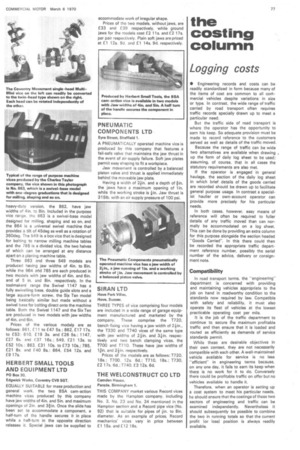the costing column
Page 79

If you've noticed an error in this article please click here to report it so we can fix it.
Logging costs
• Engineering records and costs can be readily standardized in form because many of the items of cost are common to all cornmercial vehicles despite variations in size or type. In contrast, the wide range of traffic carried by road transport often requires traffic records specially drawn up to meet a particular need: But the traffic side of road transport is where the operator has the opportunity to earn his keep. So adequate provision must be made to record reference to the customers served as well as details of the traffic moved.
Because the range of traffic can be wide two alternatives are available when drawing up the form of daily log sheet to be used; assuming, of course, that in all cases the statutory requirements are also met.
If the operator is engaged in general haulage, the section of the daily log sheet in which brief details of the goods carried are recorded should be drawn up to facilitate general purpose usage. In contrast a specialist haulier or own-account operator can provide more precisely for his particular needs.
In both cases, however, easy means of reference will often be required to fuller details of any traffic moved than can normally be accommodated on a log sheet. This can be done by providing an extra column for this purpose alongside the section headed "Goods Carried". In this there could then be recorded the appropriate traffic department reference number, possibly the serial number of the advice, delivery or consignment note.
Compatibility
In road transport terms, the "engineering" department is concerned with providing and maintaining vehicles appropriate to the job on hand in roadworthy condition to the standards now required by law. Compatible with safety and reliability, it must also operate its fleet of vehicles at the lowest practicable operating cost per mile.
It is the job of the traffic department to continue to. secure the maximum profitable traffic and then ensure that it is loaded and routed as efficiently as demands of service standards permit.
While these are desirable objectives in their own context, they are not necessarily compatible with each other. A well-maintained vehicle available for service is no less "efficient" in engineering terms because, on any one day, it fails to earn its keep when there is no work for it to do. Conversely there could be profitable traffic on offer but no vehicles available to handle it.
Therefore, when an operator is setting up a cost system to meet his particular needs, he should ensure that the costings of these two sectors of engineering and traffic can be examined independently. Nevertheless it should subsequently be possible to combine the two in running totals so that the current profit (or loss) position is always readily available.




























































































































































